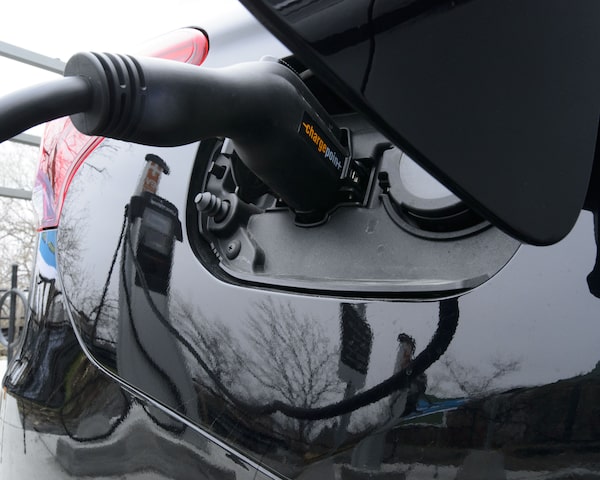
In a J.D. Power survey of more than 9,600 U.S. EV owners, people were unhappy with less than 370 km in range.Sean Kilpatrick/The Canadian Press
When it comes to range, electric cars have come a long way.
In 2011, the first Nissan Leaf to arrive in Canada boasted a 117-km estimated range. A decade later, the top-of-the-line 2021 Leaf S Plus offers 363 km in range. With more EVs delivering at least 400 km, that’s on the lower end of electric vehicle (EV) range these days.
Pricier EVs promise to take you even farther on a single charge – 652 km in the $114,000 Tesla Model S Plaid or 832 km in the upcoming $165,000 Lucid Air Grand Touring.
So as more new models hit the market, how much range will buyers demand? In the next three or four years, will 800 km be the new 400 km? Probably not, experts said.
“For mainstream vehicles, we’ll probably see things settle down into a range of about 250 to 300 miles [400 to 480 km],” said Chris Harto, senior policy analyst, transportation and energy, with Consumer Reports.
We may still see shorter ranges in some base-model EVs to bring prices more in line with their gas-powered rivals, said Brent Gruber, senior director of global automotive for J.D. Power.
But Consumer Reports’ Harto doesn’t expect a big demand for short-range EVs.
“Most of the short-range EVs have fallen off the market,” Harto said. “There may be a niche for cars with 150 miles [241 km], but they’re made to be a second car for a teenager or a car that’s used for work and errands. But if it’s the main vehicle for a family, that shorter range will be a challenge.”
But we’ll still probably continue to see high-end, extreme-range EVs, Harto said.
“At that point, you’re really talking luxury,” Harto said. “So that extra 100 miles [160 km] of range will be available, but it will add significant cost to a vehicle.”
More range means less time charging. But that convenience comes at a cost, especially for pricier cars.
For instance, the base Lucid Air, which has 406 miles (653 km) in range, will cost just under US$70,000 (C$ 87,500) – just slightly more than half as much at the Grand Touring with 179 km more range.
Among cheaper cars, the $44,000 base Nissan Leaf SV has a 240-km range. For less than $3,000 more, you can get an extra 120 km.
Within range?
How much range do buyers want?
In J.D. Power’s survey of more than 9,600 U.S. EV owners, people were unhappy with less than 370 km in range, Gruber said.
In a score for satisfaction with battery range, cars with less than 370 km in range scored 493 out of 1,000, on average. On cars with more than 370 km of range, the satisfaction score jumped to 682.
“Interestingly, when the battery range increases much beyond 370 km, satisfaction doesn’t increase all that much,” Gruber said. “There’s some diminishing return – good is good enough.”
How much range do most of us actually need?
The average Canadian drives 30 or 40 km a day. Right now, most people buying EVs can charge them at home, Harto said. That means most of us can get by with charging EVs once a week or so. Or we can plug them in every night or two to top them up.
“Most people will find that [400 to 480 km] range is good enough,” Harto said. “Then, it’s more of a question of whether the infrastructure is there and what the charging fees are.”
One benefit of more range is that you can take a long trip with fewer stops. That mattered more back when chargers were few and far between. But we’re seeing more public DC fast chargers, which get most EVs from zero to 80 per cent in 30 to 45 minutes.
Depending on where you are in Canada, that means you don’t have to worry as much about getting stranded with a dead battery or about sitting for hours at a Level 2 public charger.
In British Columbia and Quebec, for instance, there are enough fast chargers around that you can stop when you need to and quickly top up.
Need for speed?
Most of us think we need more range than we would regularly use, Harto said.
That’s because most of us don’t take that many long trips. A typical driver plugs into a fast charger four to six times a year, Harto said.
“That’s a total of single-digit hours spent fast charging over the course of a year, as long as you have a place to charge at home,” Harto said. “So if you buy anything with more than [480 km] in range, you’re not buying a whole lot of extra convenience, in my opinion.”
An extra 100 km in range may save you 20 minutes in charging on a long trip. but for most people, that’s not worth an extra $5,000 or more, Harto said.
“There will be some buyers willing to buy a 400- to 500-mile [644- to 804-km] vehicle so they almost never have to stop,” Harto said. “But I don’t know how you do that kind of trip without bio-breaks of one kind or another.”
While range still matters to buyers, expect a car’s charging speed to become increasingly important, Harto said.
That’s because EVs have a maximum speed they’ll charge at, no matter how fast the charger is. There are 350-kilowatt fast chargers now, but there are no EVs yet that can charge that fast.
“Now, 150 kW is becoming more standard and we’re seeing more cars pushing up to 200 kW or 250 kW,” Harto said. “I’m sure we’ll see 300 kW cars in a couple of years.”
At a 300 kW charger, a car may charge from zero to 80 per cent in 15 to 20 minutes – compared to 30 to 40 minutes to get that same charge at 150 kW, Harto said. That’s if the car can handle the speed.
“These minutes matter to people,” Harto said. “If you take longer trips, then a vehicle with a [480 km] range that charges faster may be more convenient than a vehicle with a [640 km] range that charges slower.”
But range and charging speed alone aren’t going to sell EVs, J.D. Power’s Gruber said.
“The standard hallmarks of the industry, such as quality and design, will remain critical to vehicle sales,” Gruber said.
As makers offer more and more EVs, it will come down to who builds the most compelling vehicles, Harto said.
“All the same things we apply to regular gas cars are increasingly applying to EVs,” Harto said. “How does it look? How does it make me feel? How does it fit my family?”
Shopping for a new car? Check out the Globe Drive Build and Price Tool to see the latest discounts, rebates and rates on new cars, trucks and SUVs. Click here to get your price.
 Jason Tchir
Jason Tchir